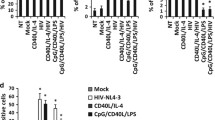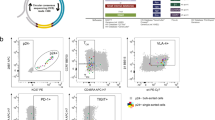Abstract
Highly-efficient antiretroviral therapy allows controlling human immunodeficiency virus (HIV) and preventing the development of immunodeficiency. However, the patients who receive therapy may develop different complications, including B-cell lymphomas. One of oncogenesis’ mechanisms in HIV-infected patients is associated with the activity of the viral Tat protein, which is able to penetrate into B-cells. In order to study the effect of the Tat protein on B-cells, a report is given on the production and characterization of the cell lines based on the cultured RPMI 8866 B-cell line demonstrating constant and inducible expression of the Tat protein.


Similar content being viewed by others
REFERENCES
Altavilla, G., Trabanelli, C., Merlin, M., et al., Morphological, histochemical, immunohistochemical, and ultrastructural characterization of tumors and dysplastic and non-neoplastic lesions arising in BK virus/tat transgenic mice, Am. J. Pathol., 1999, vol. 154, no. 4, pp. 1231–1244.
Altavilla, G., Caputo, C., Trabanelli, C., et al., Prevalence of liver tumours in HIV-1 tat-transgenic mice treated with urethane, Eur. J. Cancer, 2004, vol. 40, no. 2, pp. 275–283.
Brégnard, C., Benkirane, M., and Laguette, N., DNA damage repair machinery and hiv escape from innate immune sensing, Front. Microbiol., 2014, vol. 5, p. 176.
Carvallo, Loreto, Lopez, et al., HIV–Tat regulates macrophage gene expression in the context of neuroAIDS, PLoS One, 2017, vol. 12, no. 6.
Chipitsyna, G., Dorota, S., Siddiqui, K., et al., HIV-1 Tat increases cell survival in response to cisplatin by stimulating Rad51 gene expression, Oncogene, 2004, vol. 23, no. 15, pp. 2664–2671.
Corallini, A., Altavilla, G., Pozzi, L., et al., Systemic expression of HIV-1 Tat gene in transgenic mice induces endothelial proliferation and tumors of different histotypes, Cancer Res., 1993, vol. 53, no. 22, pp. 5569–5575.
Debaisieux, S., Rayne, F., Yezid, H., et al., The ins and outs of HIV-1 Tat, Traffic, 1993, vol. 13, no. 3, pp. 355–363.
Germini, D., Tsfasman, T., Klibi, M., et al., HIV Tat induces a prolonged myc relocalization next to IGH in circulating B-cells, Leukemia, 2017.
Gladkikh, A., Potashnikova, D., Korneva, E., et al., Cyclin D1 expression in B-cell lymphomas, Exp. Hematol., 2010, vol. 38, no. 11, pp. 1047–1057.
Hernández-Ramirez, R., Shiels, M., Dubrow, R., et al., Cancer risk in HIV-infected people in the USA from 1996 to 2012: a population-based, registry-linkage study, Lancet. HIV, 2017, vol. 4, no. 11, pp. 495–504.
Kowarz, E., Löscher, D., and Marschalek, R., Optimized sleeping beauty transposons rapidly generate stable transgenic cell lines, Biotechnol. J., 2015, vol. 10, no. 4, pp. 647–653.
Kundu, R., Sangiorgi, L., Wu, Y., et al., Expression of the human immunodeficiency virus-tat gene in lymphoid tissues of transgenic mice is associated with B-cell lymphoma, Blood, 1999, vol. 94, no. 1, pp. 275–282.
Kurnaeva, M., Sheval, E., Musinova, Y., et al., Tat basic domain: a ‘Swiss army knife’ of HIV-1 Tat?, Rev. Med. Virol., 2019.
Lefevre, E.A., Krzysiek, R., Löret, E.P., et al., Cutting edge: HIV-1 Tat protein differentially modulates the B cell response of naive, memory, and germinal center B cells, J. Immunol., 1999, vol. 163, no. 3, pp. 1119–1122.
Marban, C., Su, T., Ferrari, R., et al., Genome-wide binding map of the HIV-1 Tat protein to the human genome, PLoS One, 2011, vol. 6, p. 26894.
Musinova, Y.R. and Sheval, E.V., The accumulation of the basic domain of HIV-1 Tat protein in the nuclei and the nucleoli is different from the accumulation of full-length Tat proteins, Biopolym. Cell, 2015, vol. 31, no. 2, pp. 154–158.
Musinova, Y.R., Sheval, E.V., Dib, C., et al., Functional roles of HIV-1 Tat protein in the nucleus, Cell. Mol. Life Sci., CMLS, 2016, vol. 73, no. 3, pp. 589–601.
Reeder, J.E., Kwak, Y.T., McNamara, R.P., et al., HIV Tat controls RNA polymerase II and the epigenetic landscape to transcriptionally reprogram target immune cells, Elife, 2015, vol. 4.
Sall, F.B., El Amine, R., Markozashvili, D., et al., HIV-1 Tat protein induces aberrant activation of AICDA in human B-lymphocytes from peripheral blood, J. Cell Physiol., 2019.
Sun, Y., Huang, Y.C., Xu, Q.Z., et al., HIV-1 Tat depresses DNA-PK(CS) expression and DNA repair, and sensitizes cells to ionizing radiation, Int. J. Radiat. Oncol. Biol. Phys., 2006, vol. 65, pp. 842–850.
Vandesompele, J., De Preter, K., Pattyn, F., et al., Accurate normalization of real-time quantitative RT-PCR data by geometric averaging of multiple internal control genes, Genome Biol., 2002, vol. 3.
Vogel, J., Hinrichs, S.H., Napolitano, L.A., et al., Liver cancer in transgenic mice carrying the human immunodeficiency virus tat gene, Cancer Res., 1991, vol. 51, pp. 6686–6690.
ACKNOWLEDGMENTS
We are grateful to Eric Kowarz for kindly providing the pSBbi-GP and pSBtet-GP plasmids (Addgene рlasmids #60511 and #60495) and to Zsuzsanna Izsvak for kindly providing the SB100X plasmid (Addgene рlasmid #34879).
Funding
The work was supported by the Russian Science Foundation (grant no. 17-75-20199).
Author information
Authors and Affiliations
Corresponding author
Ethics declarations
Conflict of interests. The authors declare that they have no conflict of interests. No experimentation involving animals was part of the present work.
Additional information
Translated by E. Martynova
Rights and permissions
About this article
Cite this article
Gorbacheva, M.A., Tikhomirova, M.A., Potashnikova, D.M. et al. Production of Stable Cell Lines on the Basis of the Cultured RPMI 8866 B-Cells with Constant and Inducible Expression of the Human Immunodeficiency Virus Tat Protein. Russ J Dev Biol 50, 275–280 (2019). https://doi.org/10.1134/S1062360419050060
Received:
Revised:
Accepted:
Published:
Issue Date:
DOI: https://doi.org/10.1134/S1062360419050060




